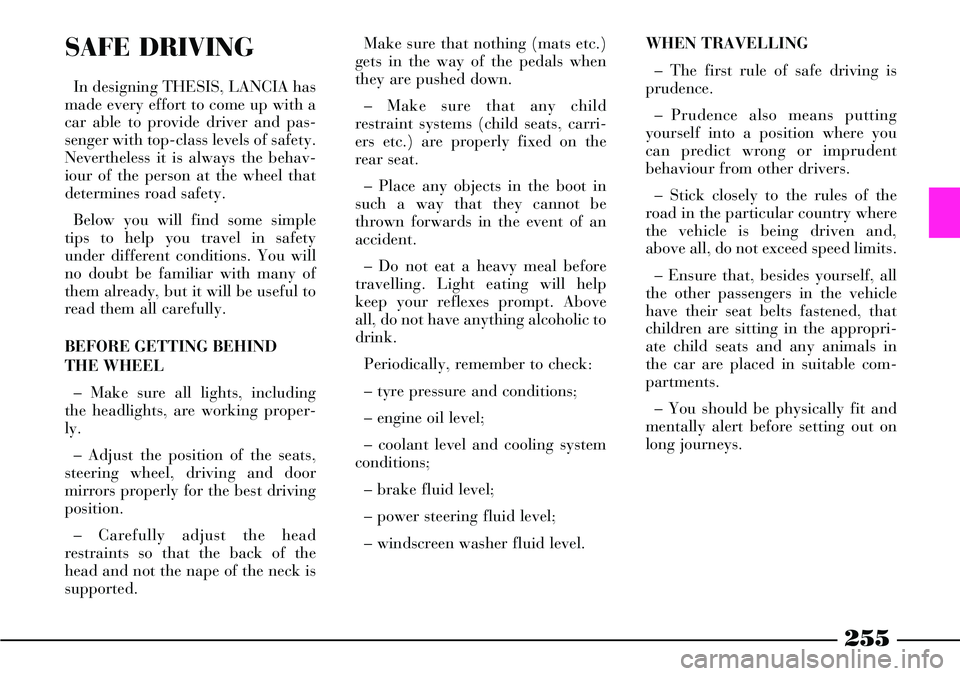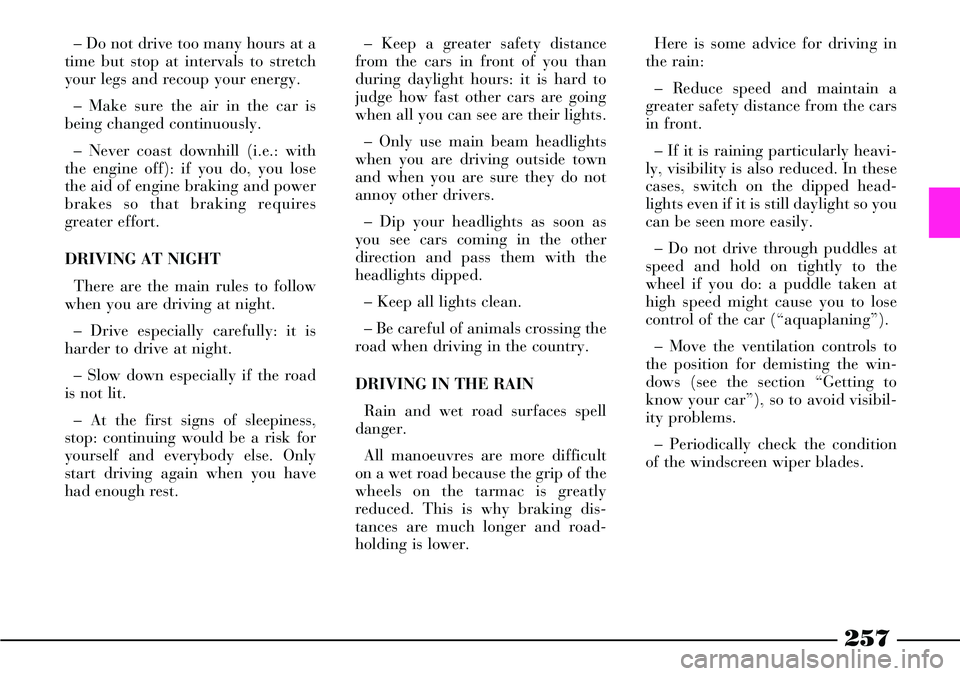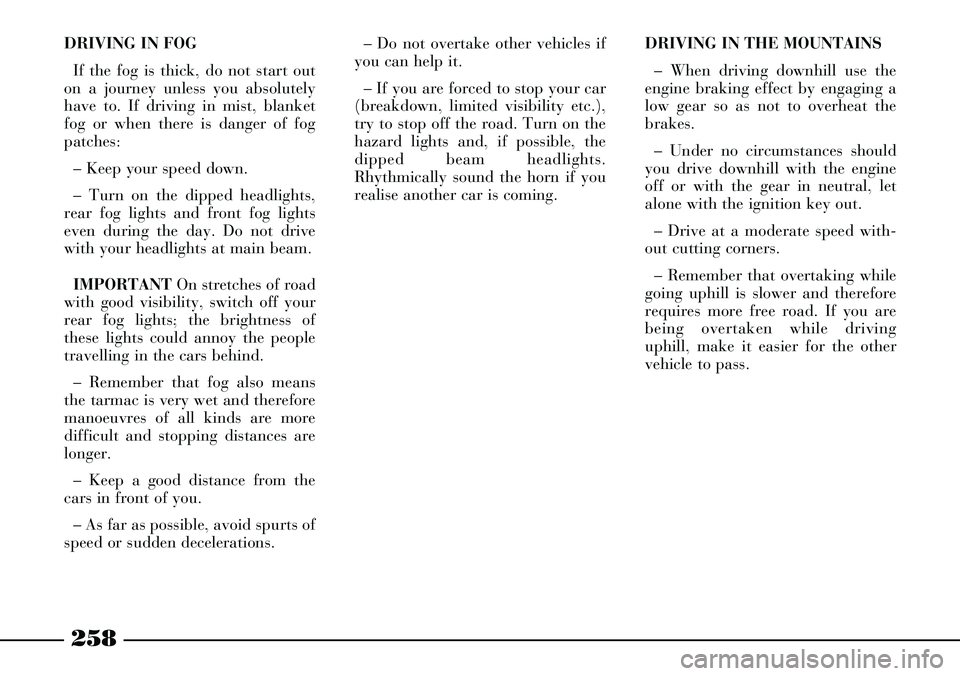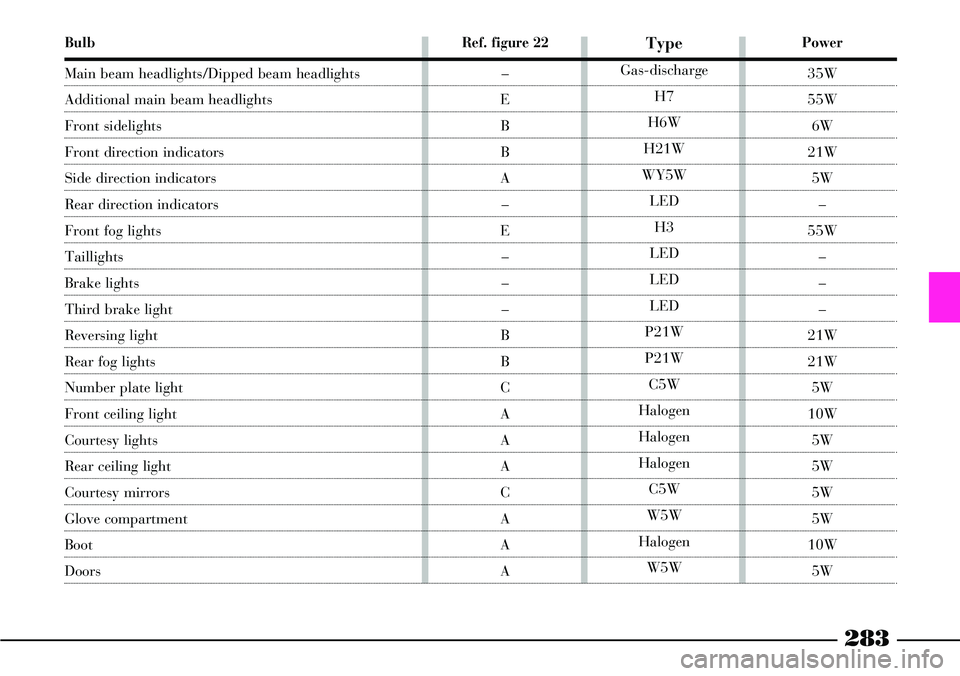headlights Lancia Thesis 2007 Owner handbook (in English)
[x] Cancel search | Manufacturer: LANCIA, Model Year: 2007, Model line: Thesis, Model: Lancia Thesis 2007Pages: 386, PDF Size: 8.69 MB
Page 175 of 386

174
Lift cover Aset at the driver's left
and press button Bto reset the fuel
cut-off switch.
Resetting the circuit breaker
Before resetting the cir-
cuit breaker, carefully
check for any fuel leaks or
damages to the car electric devices
(e.g.: headlights).Circuit breaker is located on the left
side of the boot, inside a box directly
set and connected to the battery pos-
itive terminal.
To reach the circuit breaker:
1) Open the tailgate.
2) Loosen knob A(fig. 130) and re-
move the battery cover B.
3) Press tabs A(fig. 131) and re-
move cover B.
4) Press button A(fig. 132) to reset
the circuit breaker.Initialising the control units of
the door locks, air conditioner
and ESP system
After resetting the circuit breaker, to
restore correct door locking, air con-
ditioning and ESP system, perform
the following operations:
1) Close the doors and the tailgate,
fit the key into the lock of one of the
front doors and perform a door cen-
tralised opening/closing cycle.
2) Start the engine and turn on the
compressor of the conditioner, setting
a lower temperature value than that
of the environment and check
whether the led on the disconnection
push button of the conditioner com-
pressor òis lit.
3) Turn the steering wheel one
fourth turn at least (the car can be at
standstill but the engine shall be run-
ning) and start running the car for a
few metres in a straight line until the
ESP warning light
áis off.
fig. 131
L0A0031b
fig. 132
L0A0347b
Page 243 of 386

HEADLIGHTS
GAS-DISCHARGE (BI-XENO)
MAIN BEAM / DIPPED BEAM
HEADLIGHTS AND DYNAMIC
BEAM ADJUSTMENT DEVICE
These headlights, called Bi-Xeno,
use a lamp with a xenon-filled bulb,
both for the dipped beam and the
main beam headlights.
The main characteristics of this
type of headlights are:
– higher brilliancy
– higher light beam width and
adjustability
– lower consumption under work-
ing conditions
– longer bulb life.Each headlight is equipped with an
electronic control unit used to con-
trol supply voltage. Due to high bril-
liancy, bi-Xeno headlights require
the adoption of a dynamic beam
adjustment control system.
This system is controlled by an
electronic control unit operating at
two levels:
– constant headlight beam realign-
ment as a function of the car load
– dynamic headlight beam align-
ment to compensate car pitching
when running.Operation
Light is projected onto the road by
means of a spherical glass lens with
a large surface (70 mm diameter).
A deflector lifts and lowers, so that
light distribution is different for
both the main beam and dipped
beam headlights. The deflector is
electrically operated and the
mechanical lifting/lowering opera-
tion is performed real-time when
lights are switched.
The xenon lamp consists of a bulb
containing low-pressure xenon and
two electrodes.
To obtain light emission, an elec-
tric arc must be triggered between
the two electrodes and maintained.
Each headlight is equipped with a
control unit which:
– checks the voltage/current value
under working operation
– triggers the arc to the electrodes
and cause salt evaporation at
switching on.
242
Page 244 of 386

243
Automatic dynamic beam adjust-
ment device
Bi-Xeno headlights require, due to
produced brilliancy, an automatic,
dynamic beam adjustment system.
This system is managed by an elec-
tronic control unit that controls the
actuators mounted on each dipped
beam headlight. Actuator control
depends on the processing of the sig-
nals from two orientation sensors.
This automatic dynamic beam
adjustment system provides the fol-
lowing advantages:
– it avoids dazzling the vehicles
coming from the opposite direction
– it stabilizes the illuminated area
so as to improve active safety.Headlight beam adjustment con-
trol unit
The control unit calculates the
instant car trim, by comparing the
signals from the orientation sensors.
A “correction” signal is sent to the
actuators to adapt light beam orien-
tation to the calculated car trim.
To avoid oscillation of the anti-
dazzling beam in case of particular
road surfaces (paved surfaces, dirt
roads, etc.) or abrupt movements of
the car caused by the driver (clutch
disengagement, gear change, etc.),
the control unit reduces the number
of corrections to be made on the
light unit.Fault indication
Anomalies in the operation of one
or several system components are
signalled by the lighting of symbol
6on the multifunction display,
together with message “HEAD-
LAMP INCLINATION ADJUST-
MENT SYSTEM FAULT”.
IMPORTANT In case of faults,
contact a Lancia Dealership.
In case of component anomaly or
voltage drop, the system controls in
any case system operation according
to the following logic:
– faulty front sensor: trim calcula-
tion is made by replacing the voltage
value read on the faulty sensor with
a stored, fixed value
– faulty rear sensor: the system is
switched to the safety operation
mode and keeps the headlights in a
preset position of maximum lower-
ing allowed by the light beam.
Page 245 of 386

244
– Failed connection of actuators: if
the control signal is failing, the actu-
ators will be brought back to the
position of maximum lowering per-
mitted for the light beam
– control unit failure: depending on
the type of failure, the system can
remain in the position where it was
when the failure occurred, or set
itself for the maximum lowering per-
mitted for the light beam
– voltage drop: when voltage falls
below 9 V, the system remains in the
position where it was when the fail-
ure occurred.HEADLAMP ORIENTATION FOR
LEFT-/RIGHT HAND DRIVE
The car headlights are equipped
with Bi-Xeno lamps with high light-
ing power; therefore, when you trav-
el from a country with right-hand
drive to one with left-hand drive, or
vice versa, dipped beam headlight
orientation must be modified.
This operation is necessary to avoid
dazzling the vehicle coming from the
opposite direction, as well as to opti-
mize road edge illumination.To carry out this opera-
tion, contact a Lancia
Dealership.
When you go back to
your country of origin,
remember to have the
dipped beam headlight orienta-
tion modified again.
Page 256 of 386

255
SAFE DRIVING
In designing THESIS, LANCIA has
made every effort to come up with a
car able to provide driver and pas-
senger with top-class levels of safety.
Nevertheless it is always the behav-
iour of the person at the wheel that
determines road safety.
Below you will find some simple
tips to help you travel in safety
under different conditions. You will
no doubt be familiar with many of
them already, but it will be useful to
read them all carefully.
BEFORE GETTING BEHIND
THE WHEEL
– Make sure all lights, including
the headlights, are working proper-
ly.
– Adjust the position of the seats,
steering wheel, driving and door
mirrors properly for the best driving
position.
– Carefully adjust the head
restraints so that the back of the
head and not the nape of the neck is
supported. Make sure that nothing (mats etc.)
gets in the way of the pedals when
they are pushed down.
– Make sure that any child
restraint systems (child seats, carri-
ers etc.) are properly fixed on the
rear seat.
– Place any objects in the boot in
such a way that they cannot be
thrown forwards in the event of an
accident.
– Do not eat a heavy meal before
travelling. Light eating will help
keep your reflexes prompt. Above
all, do not have anything alcoholic to
drink.
Periodically, remember to check:
– tyre pressure and conditions;
– engine oil level;
– coolant level and cooling system
conditions;
– brake fluid level;
– power steering fluid level;
– windscreen washer fluid level. WHEN TRAVELLING
– The first rule of safe driving is
prudence.
– Prudence also means putting
yourself into a position where you
can predict wrong or imprudent
behaviour from other drivers.
– Stick closely to the rules of the
road in the particular country where
the vehicle is being driven and,
above all, do not exceed speed limits.
– Ensure that, besides yourself, all
the other passengers in the vehicle
have their seat belts fastened, that
children are sitting in the appropri-
ate child seats and any animals in
the car are placed in suitable com-
partments.
– You should be physically fit and
mentally alert before setting out on
long journeys.
Page 258 of 386

257
– Keep a greater safety distance
from the cars in front of you than
during daylight hours: it is hard to
judge how fast other cars are going
when all you can see are their lights.
– Only use main beam headlights
when you are driving outside town
and when you are sure they do not
annoy other drivers.
– Dip your headlights as soon as
you see cars coming in the other
direction and pass them with the
headlights dipped.
– Keep all lights clean.
– Be careful of animals crossing the
road when driving in the country.
DRIVING IN THE RAIN
Rain and wet road surfaces spell
danger.
All manoeuvres are more difficult
on a wet road because the grip of the
wheels on the tarmac is greatly
reduced. This is why braking dis-
tances are much longer and road-
holding is lower.Here is some advice for driving in
the rain:
– Reduce speed and maintain a
greater safety distance from the cars
in front.
– If it is raining particularly heavi-
ly, visibility is also reduced. In these
cases, switch on the dipped head-
lights even if it is still daylight so you
can be seen more easily.
– Do not drive through puddles at
speed and hold on tightly to the
wheel if you do: a puddle taken at
high speed might cause you to lose
control of the car (“aquaplaning”).
– Move the ventilation controls to
the position for demisting the win-
dows (see the section “Getting to
know your car”), so to avoid visibil-
ity problems.
– Periodically check the condition
of the windscreen wiper blades. – Do not drive too many hours at a
time but stop at intervals to stretch
your legs and recoup your energy.
– Make sure the air in the car is
being changed continuously.
– Never coast downhill (i.e.: with
the engine off): if you do, you lose
the aid of engine braking and power
brakes so that braking requires
greater effort.
DRIVING AT NIGHT
There are the main rules to follow
when you are driving at night.
– Drive especially carefully: it is
harder to drive at night.
– Slow down especially if the road
is not lit.
– At the first signs of sleepiness,
stop: continuing would be a risk for
yourself and everybody else. Only
start driving again when you have
had enough rest.
Page 259 of 386

258
DRIVING IN FOG
If the fog is thick, do not start out
on a journey unless you absolutely
have to. If driving in mist, blanket
fog or when there is danger of fog
patches:
– Keep your speed down.
– Turn on the dipped headlights,
rear fog lights and front fog lights
even during the day. Do not drive
with your headlights at main beam.
IMPORTANTOn stretches of road
with good visibility, switch off your
rear fog lights; the brightness of
these lights could annoy the people
travelling in the cars behind.
– Remember that fog also means
the tarmac is very wet and therefore
manoeuvres of all kinds are more
difficult and stopping distances are
longer.
– Keep a good distance from the
cars in front of you.
– As far as possible, avoid spurts of
speed or sudden decelerations. – Do not overtake other vehicles if
you can help it.
– If you are forced to stop your car
(breakdown, limited visibility etc.),
try to stop off the road. Turn on the
hazard lights and, if possible, the
dipped beam headlights.
Rhythmically sound the horn if you
realise another car is coming. DRIVING IN THE MOUNTAINS
– When driving downhill use the
engine braking effect by engaging a
low gear so as not to overheat the
brakes.
– Under no circumstances should
you drive downhill with the engine
off or with the gear in neutral, let
alone with the ignition key out.
– Drive at a moderate speed with-
out cutting corners.
– Remember that overtaking while
going uphill is slower and therefore
requires more free road. If you are
being overtaken while driving
uphill, make it easier for the other
vehicle to pass.
Page 282 of 386

281
You should, where pos-
sible, have your bulbs
changed at a Lancia
Dealership. The correct operation
and slant of headlights is essen-
tial for safe driving and compli-
ance with legal requirements.IF A BULB BURNS
OUT
Modifications or repairs
to the electrical system
carried out incorrectly
and without bearing the features
of the system in mind can cause
malfunctions with the risk of fire.
The bulbs of (bi-Xeno)
gas-discharge headlights
must be replaced by a
Lancia Dealership.
Only touch the metal
part when handling halo-
gen bulbs. You will
reduce the light intensity and
possibly compromise bulb life by
touching the glass bulb. If you
touch the bulb accidentally, rub
it with a cloth moistened with
alcohol and leave it to dry.
Halogen bulbs contain
pressurised gas which, if
broken, may cause small
fragments of glass to be projected
outwards.
Due to high voltage, the
bulb of bi-Xeno gas-dis-
charge headlights must
only be replaced by experts: dan-
ger of death! Contact the Lancia
Dealership.
Page 284 of 386

283
Bulb
Main beam headlights/Dipped beam headlights
Additional main beam headlights
Front sidelights
Front direction indicators
Side direction indicators
Rear direction indicators
Front fog lights
Taillights
Brake lights
Third brake light
Reversing light
Rear fog lights
Number plate light
Front ceiling light
Courtesy lights
Rear ceiling light
Courtesy mirrors
Glove compartment
Boot
Doors
Power
35W
55W
6W
21W
5W
–
55W
–
–
–
21W
21W
5W
10W
5W
5W
5W
5W
10W
5W
Type
Gas-discharge
H7
H6W
H21W
WY5W
LED
H3
LED
LED
LED
P21W
P21W
C5W
Halogen
Halogen
Halogen
C5W
W5W
Halogen
W5W
Ref. figure 22
–
E
B
B
A
–
E
–
–
–
B
B
C
A
A
A
C
A
A
A
Page 285 of 386

284
IF AN EXTERIOR
BULB BURNS OUT
FRONT LIGHT CLUSTER
The front light cluster includes
main beam headlights/dipped beam
headlights, additional main beam
headlights, direction indicators and
sidelights.Light layout is the following
(fig. 23):
A– Main beam headlight/dipped
beam headlight (bi-Xeno bulb)
B– Sidelight
C– Additional main beam head-
light
D– Direction indicator.Any operation on the
front light cluster must be
made with the stalk at 0
(lights off) and ignition key
removed for at least 15 minutes
(to let bulb cooling and con-
densers discharging): risk of elec-
trical discharge!
fig. 23
L0A0106b
To replace front head-
light bulbs, front light
clusters shall be removed.
It is therefore recommended to
the bulbs replaced at Lancia
Dealership.Due to high voltage, the
bulb of bi-Xeno gas-dis-
charge headlights must
only be replaced by experts: dan-
ger of death! Contact the Lancia
Dealership.